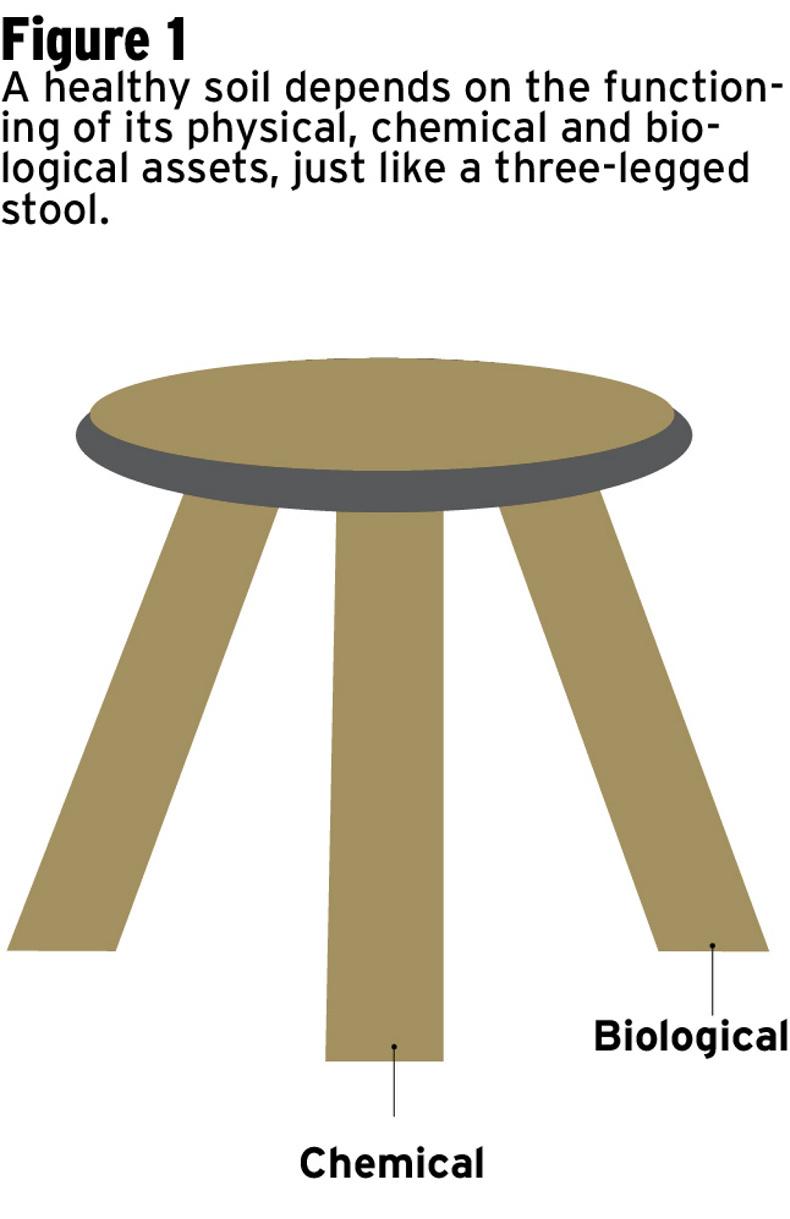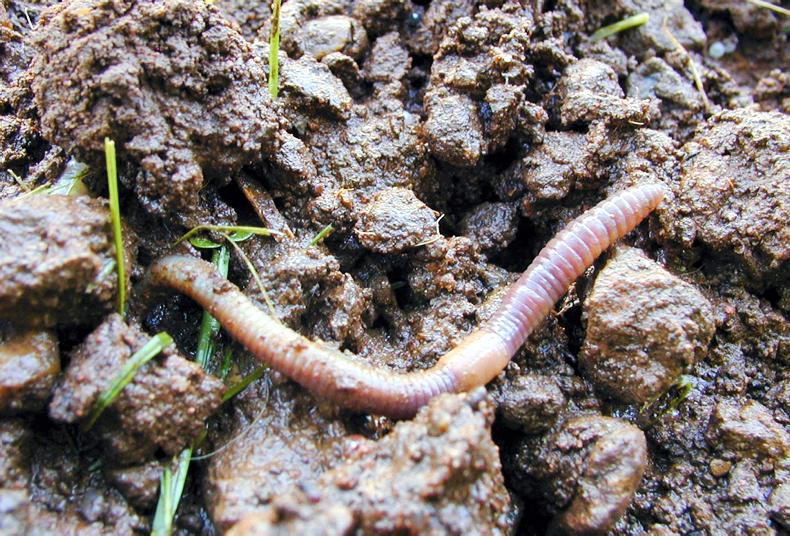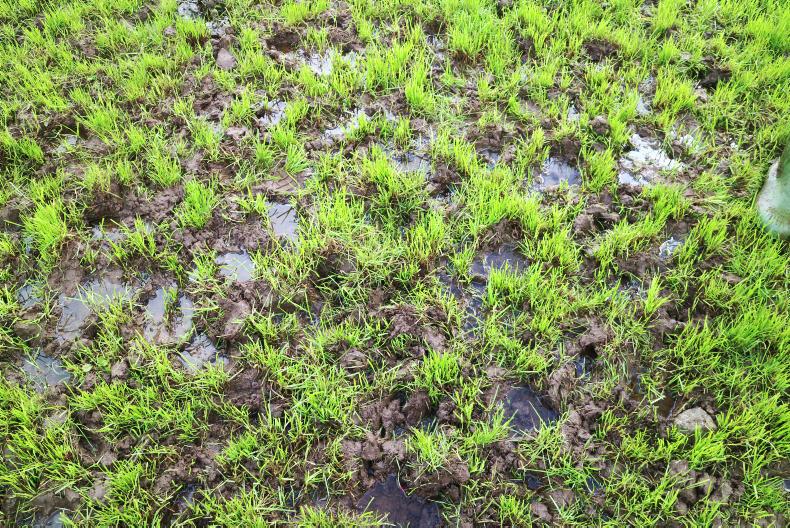Your land is your primary asset and the soil governs output potential, regardless of what you grow on it. Healthy soil brings two major benefits. It is capable of growing more output and it may also help reduce the cost of production. Any reduction in the cost of primary agricultural production is of benefit to all farmers.
The soil beneath our feet has been broadly neglected over the past few decades in favour of technical considerations that relate to animal performance or crop protection. These have been the sexy considerations of recent times and very many farmers have neglected to look after the land they are farming. As the price cost squeeze intensifies, we do well to remember that if you look after your soil it will be better able to look after you.
Three facets
For a soil to be productive it must possess good physical, chemical and biological characteristics.
It must be physically sound, which means good structure, no compaction, good water percolation and drainage etc. This enables plants to grow to their maximum by providing an environment in which roots can grow, breathe and access nutrients. Soils are degraded naturally by weather events like rain and heat and also by machinery, cultivation and animals. Structure repair is a characteristic of a healthy soil.The chemical phase of soil provides the fertility and the nutrients to enable plants in a well-structured soil to deliver to their potential. This means major and minor nutrients in a pH environment that is regarded as optimum for specific crops. The third phase involves all the biological life that takes place in the soil. This is perhaps the most important aspect of a healthy soil as many of the soil-borne livestock play a part in soil restructuring and also help with nutrient release through mineralisation. But biology has also been the most neglected facet. Just like what happens above ground, the livestock below the ground also need to be fed and many modern farming systems have ignored this requirement for years.All soils need to have these three functions or characteristics. Soil is a bit like a three-legged stool – if one leg is missing, it will topple over (Figure 1). In the same way soils, where only the physical or chemical aspects are being looked after, are very unlikely to be at their most productive.

Structure
Soils are basically a combination of the sand, silt and clay, plus organic matter. These set the natural texture of a soil. The percentages of each give it an official description (Figure 2) and this is seldom modified (possibly if you were to bring thousands of tonnes of sand on to a clay-type soil). Soil structure is the way in which the sand, silt and clay particles are organised into particles that are known as aggregates or crumbs. A mix of sand, silt and clay is still only a mix and it is the presence of organic materials that bind all these together that give a soil its structure.
![]()
The soil animals have an important part to play in this process. Earthworms burrow through the soil leaving channels for water percolation. They also consume much of the fine soil particles, along with the organic matter they eat, and this mix is passed through them. This combination is then the source of feed for other smaller organisms which tend to bind “lumps” together to form aggregates or crumbs. These are irregularly shaped so good structure has space for air and water between the crumbs and also for roots to grow and forage for their nutrients.
 The process of structure regeneration cannot take place if there is not an active biological presence in the soil and earthworms are key. The number of earthworms and their activity will be influenced by the amount of feed available to them. That is why tillage farmers are advised to incorporate some form of organic matter into their soils to help them restructure. But one might ask if there is enough suitable organic matter available in efficiently grazed or cut grassland to support adequate earthworm activity? Could very high grass utilisation leave you short-changed in other areas?
The process of structure regeneration cannot take place if there is not an active biological presence in the soil and earthworms are key. The number of earthworms and their activity will be influenced by the amount of feed available to them. That is why tillage farmers are advised to incorporate some form of organic matter into their soils to help them restructure. But one might ask if there is enough suitable organic matter available in efficiently grazed or cut grassland to support adequate earthworm activity? Could very high grass utilisation leave you short-changed in other areas?
Good structure allows for easier working of a soil. Improved water percolation widens the work window as the soil is better able to drain. And healthy well-structured soils are more productive.
Fertility
Soil fertility is very important for crop productivity. Adequate soil pH is most important as it encourages the soil biology to thrive as well as optimising nutrient availability.
When pH is optimum, the P and K already in the soil is made more available to plant roots and soil test levels will increase even though only lime was applied. The cost benefit ratio for lime is said to be 1:7 – spend €20 on lime, where it is needed, and the increased output is worth over €140 extra.
Optimum pH is crop-specific and is altered slightly on some soil types such as organic soils or soils where nutrients such as molybdenum can be high and increased availability may cause other problems. For most mineral soils the optimum grassland pH is at or above 6.3, while individual cereals need 6.5 to 7.0 pH. Some crops, such as potatoes and oats, can cope with pH levels down to 6.0 while beet, beans and peas need to be up at pH 7.0.
Lime affects nutrient availability and crop growth by altering soil acidity. Higher pH levels also increase micro-organism activity and their ability to break down plant and animal residues to recycle nutrients. In this way it also influences soil structure by enhancing the activity of the organisms that act to improve it.
Fertiliser use should be guided by soil test results. A test must be representative of the area being sampled. Areas of variable performance within a field should have separate tests. Undisturbed soils tend to show layered fertility – this means more nutrients close to the top but less lower down in the profile. This could result in shallow rooting over time. Consider taking soil samples to about 8in deep.
Soil tests provide an indication of the pH of the soil plus the level of available P and K. Be aware that P and K levels are likely to increase following lime application and this makes lime the primary fertiliser. After pH is optimised, plant performance will be best where P and K are at Index 3. Extra applied fertiliser is less efficient than having a higher soil index.
Additional P & K can be applied to higher yielding crops and current recommendations allow for replacement of nutrient offtake, plus fertility building from lower indices. Productivity is nearly always higher on high soil indices so it is best to strive for fertile soil.
Read more
Special focus: fertiliser
Your land is your primary asset and the soil governs output potential, regardless of what you grow on it. Healthy soil brings two major benefits. It is capable of growing more output and it may also help reduce the cost of production. Any reduction in the cost of primary agricultural production is of benefit to all farmers.
The soil beneath our feet has been broadly neglected over the past few decades in favour of technical considerations that relate to animal performance or crop protection. These have been the sexy considerations of recent times and very many farmers have neglected to look after the land they are farming. As the price cost squeeze intensifies, we do well to remember that if you look after your soil it will be better able to look after you.
Three facets
For a soil to be productive it must possess good physical, chemical and biological characteristics.
It must be physically sound, which means good structure, no compaction, good water percolation and drainage etc. This enables plants to grow to their maximum by providing an environment in which roots can grow, breathe and access nutrients. Soils are degraded naturally by weather events like rain and heat and also by machinery, cultivation and animals. Structure repair is a characteristic of a healthy soil.The chemical phase of soil provides the fertility and the nutrients to enable plants in a well-structured soil to deliver to their potential. This means major and minor nutrients in a pH environment that is regarded as optimum for specific crops. The third phase involves all the biological life that takes place in the soil. This is perhaps the most important aspect of a healthy soil as many of the soil-borne livestock play a part in soil restructuring and also help with nutrient release through mineralisation. But biology has also been the most neglected facet. Just like what happens above ground, the livestock below the ground also need to be fed and many modern farming systems have ignored this requirement for years.All soils need to have these three functions or characteristics. Soil is a bit like a three-legged stool – if one leg is missing, it will topple over (Figure 1). In the same way soils, where only the physical or chemical aspects are being looked after, are very unlikely to be at their most productive.

Structure
Soils are basically a combination of the sand, silt and clay, plus organic matter. These set the natural texture of a soil. The percentages of each give it an official description (Figure 2) and this is seldom modified (possibly if you were to bring thousands of tonnes of sand on to a clay-type soil). Soil structure is the way in which the sand, silt and clay particles are organised into particles that are known as aggregates or crumbs. A mix of sand, silt and clay is still only a mix and it is the presence of organic materials that bind all these together that give a soil its structure.
![]()
The soil animals have an important part to play in this process. Earthworms burrow through the soil leaving channels for water percolation. They also consume much of the fine soil particles, along with the organic matter they eat, and this mix is passed through them. This combination is then the source of feed for other smaller organisms which tend to bind “lumps” together to form aggregates or crumbs. These are irregularly shaped so good structure has space for air and water between the crumbs and also for roots to grow and forage for their nutrients.
 The process of structure regeneration cannot take place if there is not an active biological presence in the soil and earthworms are key. The number of earthworms and their activity will be influenced by the amount of feed available to them. That is why tillage farmers are advised to incorporate some form of organic matter into their soils to help them restructure. But one might ask if there is enough suitable organic matter available in efficiently grazed or cut grassland to support adequate earthworm activity? Could very high grass utilisation leave you short-changed in other areas?
The process of structure regeneration cannot take place if there is not an active biological presence in the soil and earthworms are key. The number of earthworms and their activity will be influenced by the amount of feed available to them. That is why tillage farmers are advised to incorporate some form of organic matter into their soils to help them restructure. But one might ask if there is enough suitable organic matter available in efficiently grazed or cut grassland to support adequate earthworm activity? Could very high grass utilisation leave you short-changed in other areas?
Good structure allows for easier working of a soil. Improved water percolation widens the work window as the soil is better able to drain. And healthy well-structured soils are more productive.
Fertility
Soil fertility is very important for crop productivity. Adequate soil pH is most important as it encourages the soil biology to thrive as well as optimising nutrient availability.
When pH is optimum, the P and K already in the soil is made more available to plant roots and soil test levels will increase even though only lime was applied. The cost benefit ratio for lime is said to be 1:7 – spend €20 on lime, where it is needed, and the increased output is worth over €140 extra.
Optimum pH is crop-specific and is altered slightly on some soil types such as organic soils or soils where nutrients such as molybdenum can be high and increased availability may cause other problems. For most mineral soils the optimum grassland pH is at or above 6.3, while individual cereals need 6.5 to 7.0 pH. Some crops, such as potatoes and oats, can cope with pH levels down to 6.0 while beet, beans and peas need to be up at pH 7.0.
Lime affects nutrient availability and crop growth by altering soil acidity. Higher pH levels also increase micro-organism activity and their ability to break down plant and animal residues to recycle nutrients. In this way it also influences soil structure by enhancing the activity of the organisms that act to improve it.
Fertiliser use should be guided by soil test results. A test must be representative of the area being sampled. Areas of variable performance within a field should have separate tests. Undisturbed soils tend to show layered fertility – this means more nutrients close to the top but less lower down in the profile. This could result in shallow rooting over time. Consider taking soil samples to about 8in deep.
Soil tests provide an indication of the pH of the soil plus the level of available P and K. Be aware that P and K levels are likely to increase following lime application and this makes lime the primary fertiliser. After pH is optimised, plant performance will be best where P and K are at Index 3. Extra applied fertiliser is less efficient than having a higher soil index.
Additional P & K can be applied to higher yielding crops and current recommendations allow for replacement of nutrient offtake, plus fertility building from lower indices. Productivity is nearly always higher on high soil indices so it is best to strive for fertile soil.
Read more
Special focus: fertiliser

 The process of structure regeneration cannot take place if there is not an active biological presence in the soil and earthworms are key. The number of earthworms and their activity will be influenced by the amount of feed available to them. That is why tillage farmers are advised to incorporate some form of organic matter into their soils to help them restructure. But one might ask if there is enough suitable organic matter available in efficiently grazed or cut grassland to support adequate earthworm activity? Could very high grass utilisation leave you short-changed in other areas?
The process of structure regeneration cannot take place if there is not an active biological presence in the soil and earthworms are key. The number of earthworms and their activity will be influenced by the amount of feed available to them. That is why tillage farmers are advised to incorporate some form of organic matter into their soils to help them restructure. But one might ask if there is enough suitable organic matter available in efficiently grazed or cut grassland to support adequate earthworm activity? Could very high grass utilisation leave you short-changed in other areas? 





 This is a subscriber-only article
This is a subscriber-only article














SHARING OPTIONS: